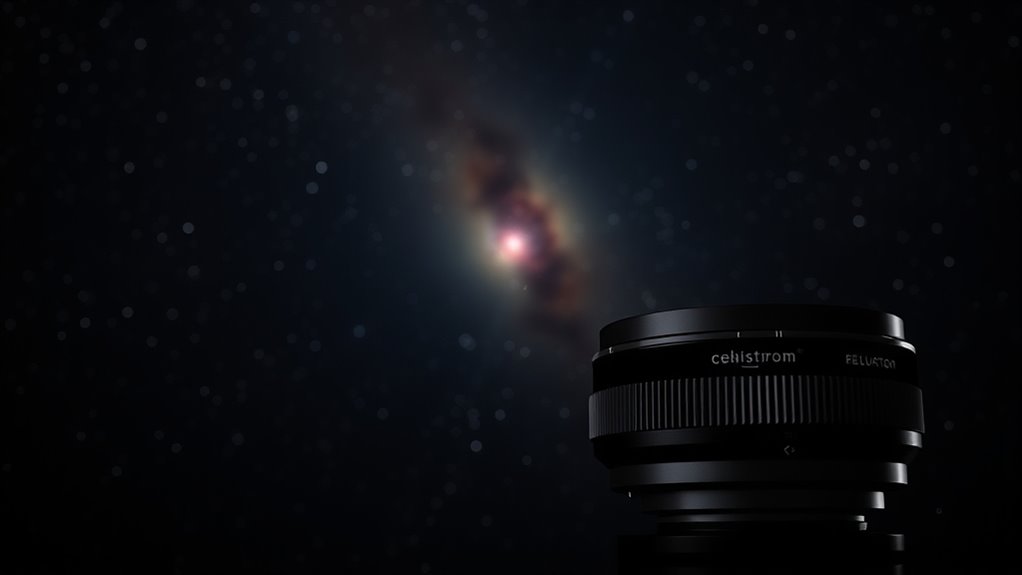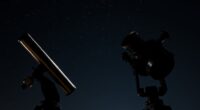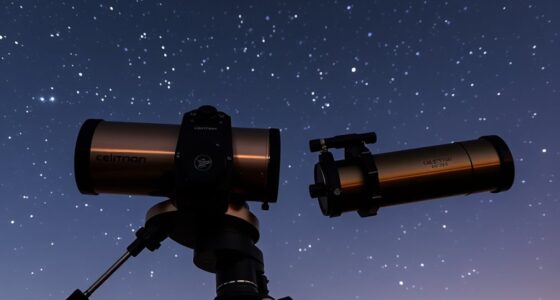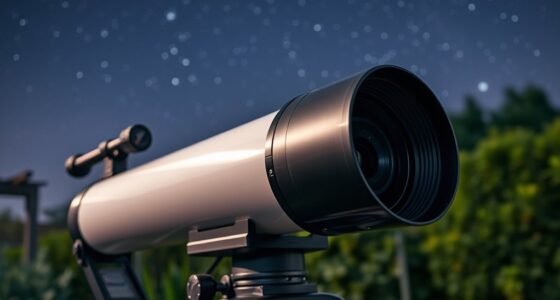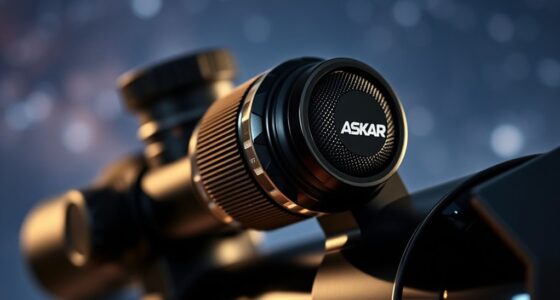If you’re looking to improve your astrophotography in 2025, I recommend exploring 14 of the best Celestron focal reducers available. These units can expand your telescope’s field of view, boost light gathering, and support prime focus imaging. They include versatile options like the .7X EdgeHD reducer, the Astromania models, GSO 0.5X reducers, and more, all designed to enhance your sky captures. Keep exploring, and you’ll discover the perfect tools to upgrade your astrophotography setup.
Key Takeaways
- Prioritize models with fully multi-coated optics and high-quality glass for optimal image brightness and sharpness.
- Ensure compatibility with your specific Celestron SCT or EdgeHD telescope model, considering mounting threads and adapters.
- Consider focal reduction ratios (e.g., 0.5x to 0.7x) that expand the field of view for wider sky coverage and improved astrophotography.
- Opt for durable, CNC-machined aluminum reducers with secure threaded connections for stability during imaging sessions.
- Review user feedback and professional recommendations for the latest models supporting advanced astrophotography in 2025.
Celestron Focal Reducer & Field Corrector for Telescopes
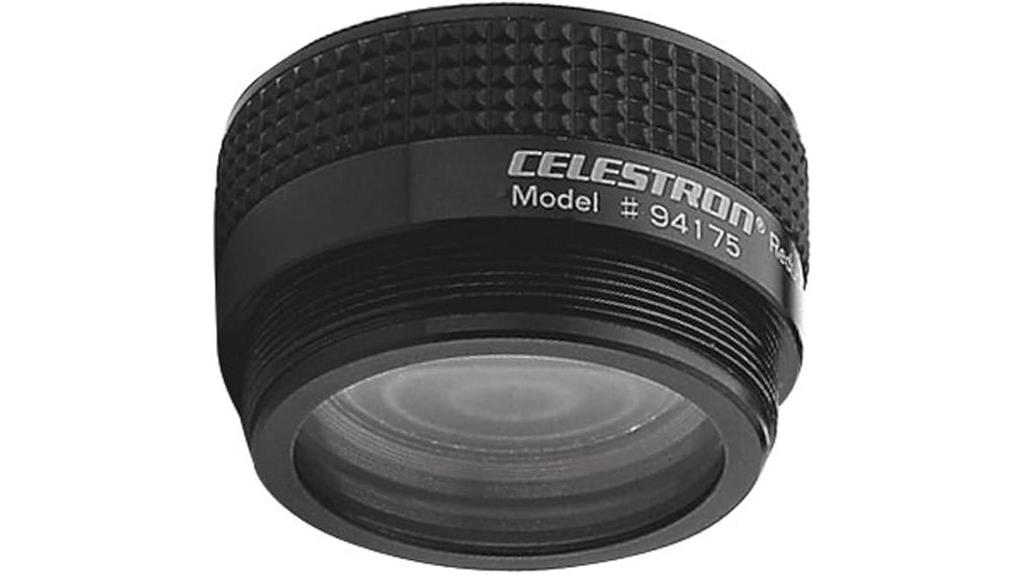
If you’re looking to expand your astrophotography capabilities, the Celestron Focal Reducer & Field Corrector is a must-have accessory, especially for Schmidt-Cassegrain telescope users. It reduces your telescope’s focal length and ratio by 37%, turning f/10 into f/6.3 and f/11 into f/7, which broadens your field of view and speeds up imaging. Simply thread the reducer onto your telescope’s rear, and it works seamlessly with your existing accessories like T-Adapters and star diagonals. The multi-coated lens maximizes light transmission, providing brighter images and better low-light performance, making it ideal for deep-sky imaging and terrestrial digiscoping.
Best For: amateur astronomers and astrophotographers seeking to enhance their telescope’s versatility and low-light imaging capabilities with an easy-to-use focal reducer.
Pros:
- Reduces focal length and ratio by 37%, broadening the field of view for deep-sky imaging.
- Fully multi-coated lens maximizes light transmission, resulting in brighter images.
- Compatible with all accessories like T-Adapters, star diagonals, and off-axis guiders for seamless integration.
Cons:
- Designed primarily for Schmidt-Cassegrain telescopes, limiting compatibility with other types of telescopes.
- May require precise threading and setup, which could be challenging for beginners.
- As an accessory, it adds an extra component that could potentially introduce optical alignment issues if not properly handled.
Astromania Focal Reducer for Telescope Eyepiece
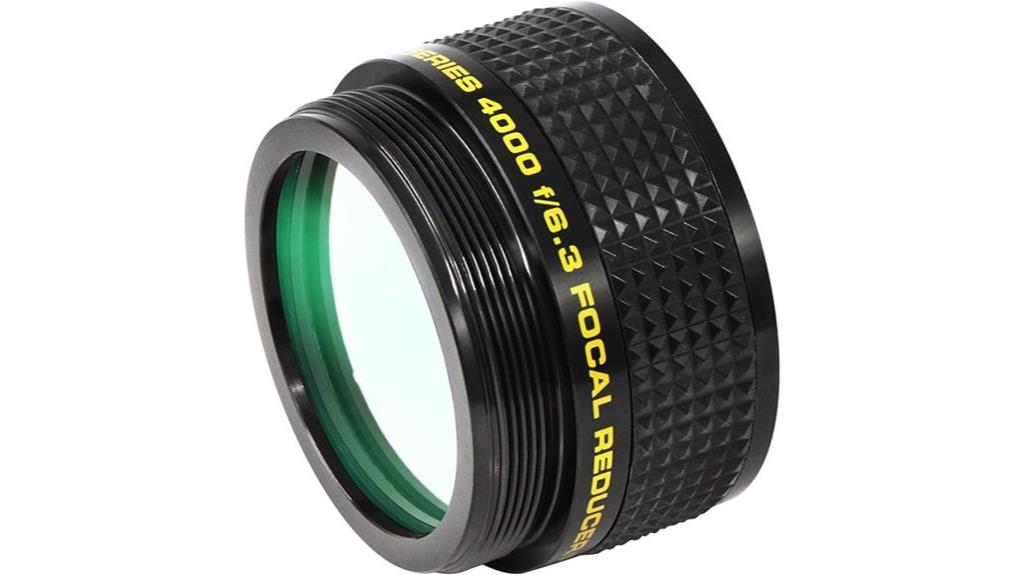
The Astromania Focal Reducer for Telescope Eyepiece stands out for its compatibility with a wide range of Celestron Schmidt-Cassegrain telescopes, making it an ideal choice for astrophotographers seeking versatile and reliable accessories. This f/6.3 reducer features a fully multi-coated, 4-element optical system that reduces focal length by 37%, transforming f/10 systems into faster setups with broader fields of view. Crafted from durable aerospace-grade aluminum with shock-absorbing rubber housing, it includes dust caps and a protective case. With a 41mm clear aperture and excellent image quality, it’s a popular, highly-rated tool for enhancing deep-sky imaging and celestial observation.
Best For: astrophotographers and amateur astronomers using Celestron Schmidt-Cassegrain telescopes who want to expand their field of view and imaging capabilities with a durable, high-quality focal reducer.
Pros:
- Fully multi-coated, 4-element optical system provides sharp, clear images with minimized chromatic aberration
- Reduces focal length by 37%, enabling wider fields of view for deep-sky imaging and celestial observation
- Constructed from durable aerospace-grade aluminum with shock-absorbing rubber housing, ensuring stability and longevity
Cons:
- Compatible only with specific Celestron Schmidt-Cassegrain telescope models, limiting versatility with other brands
- Slightly increased complexity in setup may require additional adapters or accessories for some users
- May add weight and size to the optical train, which could impact balance on some mounts
Celestron Reducer Lens .7X – EdgeHD 800 – Increases Field of View 43%

For astrophotographers aiming to capture wider, more detailed images of the night sky, the Celestron Reducer Lens .7X for EdgeHD 800 stands out. It increases the telescope’s field of view by 43%, allowing me to encompass more of the sky in my shots. The fully multi-coated optics ensure brighter, clearer images with better contrast, perfect for deep-sky objects. Its .7x compression factor reduces exposure times and enhances image scale. Designed specifically for the EdgeHD 800, it maintains sharp focus across the entire field. Weighing just 0.8 pounds, it’s lightweight and easy to handle, making my astrophotography sessions more efficient and enjoyable.
Best For: astrophotographers seeking to expand their telescope’s field of view and improve image clarity for detailed deep-sky imaging with the EdgeHD 800.
Pros:
- Increases field of view by 43%, capturing more of the night sky in each shot
- Fully multi-coated optics provide brighter, clearer images with enhanced contrast
- Lightweight design (0.8 lbs) makes it easy to handle and adds minimal weight to the telescope setup
Cons:
- Designed specifically for EdgeHD 800, limiting compatibility with other telescope models
- May require precise focusing adjustments due to optics compression factor
- Slightly adds to the overall setup complexity for beginners
Astromania Focal Reducer for Telescopes
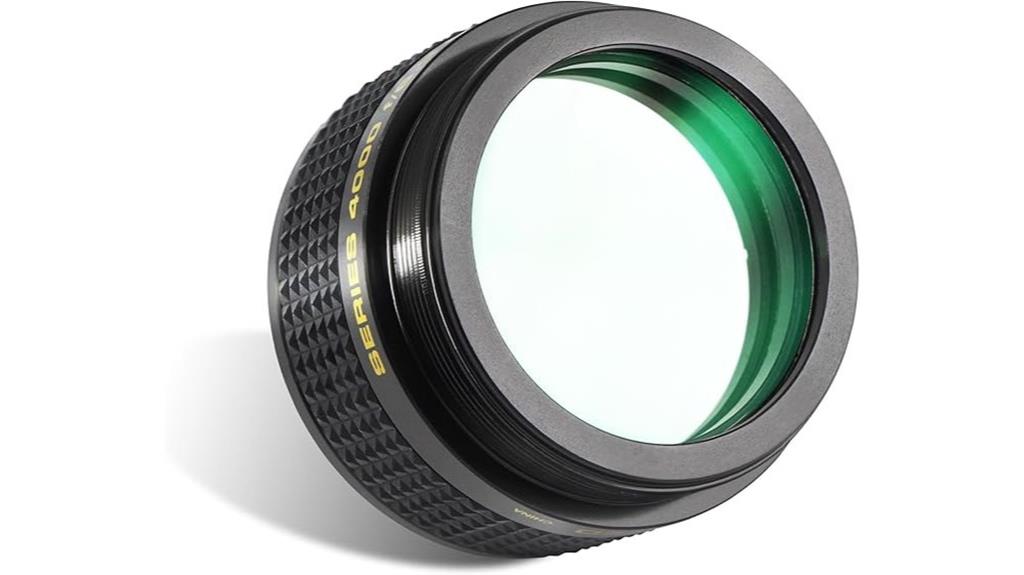
Astromania’s Focal Reducer for Telescopes stands out as an excellent choice for amateur and professional astronomers seeking to expand their deep-sky imaging capabilities. It reduces focal length by 37%, transforming an f/10 system into f/6.3, which provides a wider field of view without losing image quality. Its 4-element, fully multi-coated optics ensure maximum light transmission and minimal chromatic aberration. Compatible with all Celestron SCT models, including NexStar, Evolution, and EdgeHD series, it’s built from durable CNC-machined aluminum. This sharp, compact accessory makes imaging faster and more versatile, enhancing your telescope’s functionality while maintaining crisp, detailed celestial views.
Best For: amateur and professional astronomers seeking to enhance their deep-sky imaging with wider fields of view and high-quality optics.
Pros:
- Significantly reduces focal length by 37%, enabling wider viewing angles.
- Fully multi-coated optics with 41mm clear aperture for optimal light transmission and minimal aberrations.
- Compatible with all Celestron SCT models, including NexStar, Evolution, and EdgeHD series, offering versatile use.
Cons:
- Requires proper attachment to compatible telescopes, which may involve additional adapters.
- Slightly increased complexity in setup for beginners unfamiliar with focal reducers.
- Made from CNC-machined aluminum, which, while durable, can be heavier than plastic alternatives, potentially affecting portability.
Astromania Focal Reducer for Telescopes

If you’re looking to expand your astrophotography capabilities without sacrificing image quality, the Astromania Focal Reducer for Telescopes stands out as an excellent choice. Designed specifically for Celestron SCTs, it reduces the focal length by 37%, transforming f/10 systems into faster f/6.3 setups. Its multi-coated, 4-element optics deliver crisp, clear images with minimal aberration, while the durable CNC-machined aluminum construction ensures stability. Lightweight and easy to attach, it also includes dust caps and a protective case. With high user ratings, it’s a versatile accessory that broadens your field of view and enhances deep-sky imaging potential.
Best For: amateur and professional astronomers seeking to enhance their astrophotography and deep-sky imaging capabilities with a reliable, easy-to-use focal reducer compatible with Celestron SCT telescopes.
Pros:
- Reduces focal length by 37%, enabling wider fields of view for celestial observation and imaging.
- Multi-coated, 4-element optical system ensures crisp, clear images with minimal aberration.
- Durable CNC-machined aluminum construction with shock-absorbing rubber housing provides stability and longevity.
Cons:
- Only compatible with Celestron SCT models, limiting its use with other telescope types.
- Slightly increased setup complexity for beginners unfamiliar with focal reducers.
- Additional accessories like dust caps and cases may be necessary for optimal protection and storage.
Celestron Reducer Lens .7X – EdgeHD 925 – Increases Field of View 43%
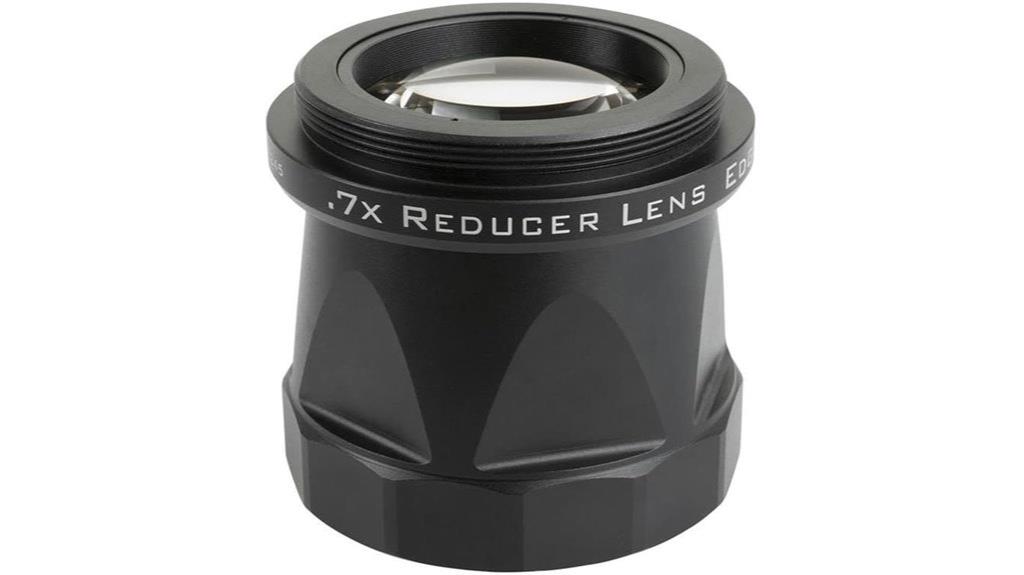
The Celestron Reducer Lens .7X for EdgeHD 925 stands out as an ideal choice for astrophotographers seeking to expand their celestial horizons. It increases the telescope’s field of view by 43%, allowing me to capture more of the night sky in a single shot. Its fully multi-coated optics ensure bright, sharp images with maximum light transmission. Designed specifically for the EdgeHD 925, it maintains a back focus of 105mm, shortens exposure times, and improves image scale. Weighing only 0.8 pounds, it’s lightweight and easy to handle, seamlessly integrating with my telescope and enhancing deep-sky imaging.
Best For: astrophotographers and amateur astronomers looking to enhance their EdgeHD 925 telescope’s field of view and imaging capabilities.
Pros:
- Significantly increases field of view by 43%, enabling wider sky captures.
- Fully multi-coated optics ensure bright, sharp, and clear images with maximum light transmission.
- Lightweight design (0.8 lbs) makes handling easy and maintains mount stability during long exposures.
Cons:
- Designed specifically for EdgeHD 925, limiting compatibility with other telescope models.
- May require additional adapters for seamless integration with some setups.
- Shorter exposure times may necessitate precise tracking and stable mounts for optimal results.
Astromania Focal Reducer for Telescopes
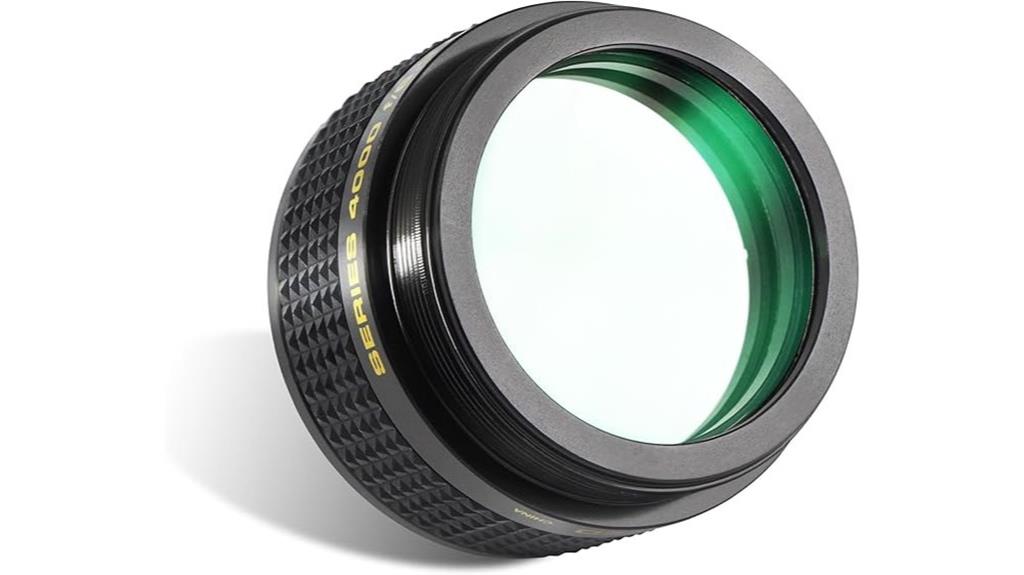
For astronomers seeking to expand their deep-sky imaging capabilities, the Astromania Focal Reducer stands out as a versatile and reliable accessory. It reduces focal length by 37%, turning an f/10 system into f/6.3, which provides a wider field of view. Its 4-element, fully multi-coated optics ensure maximum light transmission, minimal chromatic aberration, and crisp images. Compatible with all Celestron SCTs, including NexStar, Evolution, and EdgeHD models, it’s perfect for both imaging and observation. Made from durable CNC-machined aluminum with shock-absorbing rubber housing, it offers a compact, protective design that enhances your telescope’s performance without sacrificing image quality.
Best For: amateur and professional astronomers looking to enhance their deep-sky imaging and observation capabilities with a versatile focal reducer compatible with Celestron SCT telescopes.
Pros:
- Significantly reduces focal length by 37%, expanding the field of view for wider astrophotography and observation.
- Fully multi-coated 4-element optics ensure maximum light transmission and high image clarity with minimal aberrations.
- Durable CNC-machined aluminum construction with shock-absorbing rubber housing provides reliable protection and longevity.
Cons:
- Compatibility limited to Celestron SCT models; not suitable for other telescope types.
- May require additional adapters or accessories for specific setups or mounting configurations.
- As a focal reducer, it may introduce slight vignetting or optical distortions if not properly aligned or used with incompatible accessories.
Celestron Reducer Lens .7X EdgeHD TM 1400
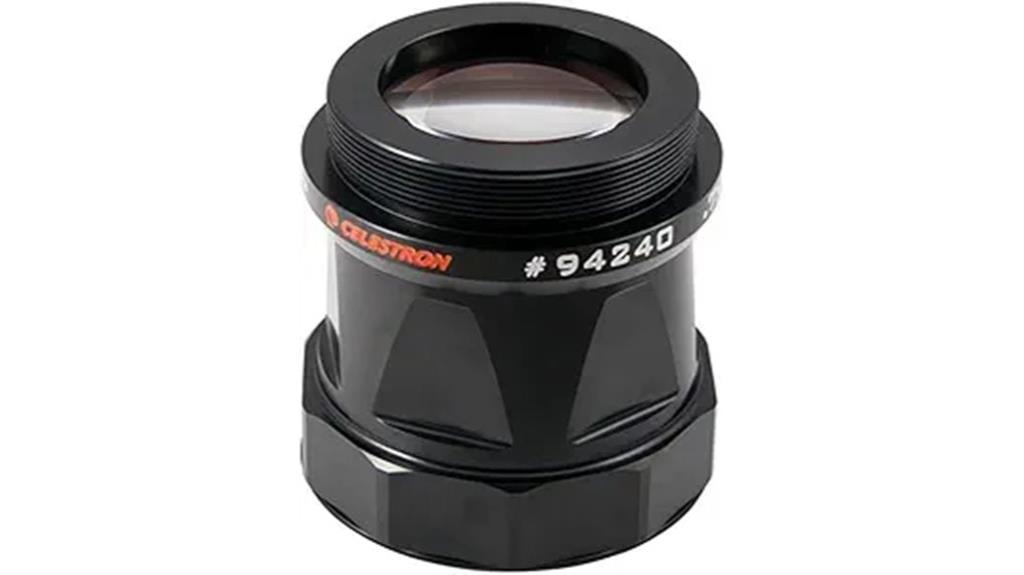
Designed specifically for EdgeHD 1400 telescopes, the Celestron Reducer Lens .7X EdgeHD TM 1400 offers a seamless connection with 3.25-inch threads, making it ideal for astrophotographers seeking improved wide-field imaging. Its 4-element optical design with Lanthanum glass and multi-layer coatings delivers sharp, bright images with minimal aberrations. It increases the field of view by 43% and shortens exposure times, enabling faster captures. Fully multi-coated optics and a sturdy CNC-machined aluminum housing ensure durability and superior performance. Though discontinued, it remains a popular choice for those wanting professional-grade images with enhanced efficiency and quality.
Best For: astrophotographers seeking to enhance their EdgeHD 1400 telescope’s wide-field imaging, speed, and image quality.
Pros:
- Increases field of view by 43%, capturing more celestial objects in a single frame
- Shortens exposure times for faster imaging sessions
- Built with durable CNC-machined aluminum housing and high-quality optical elements
Cons:
- Discontinued product, potentially affecting availability and support
- Requires compatible EdgeHD 1400 telescope and threaded connection
- Slightly heavier weight (3.85 pounds) may impact mounting setup or balance
SVBONY 0.5X Focal Reducer for Telescope Eyepiece
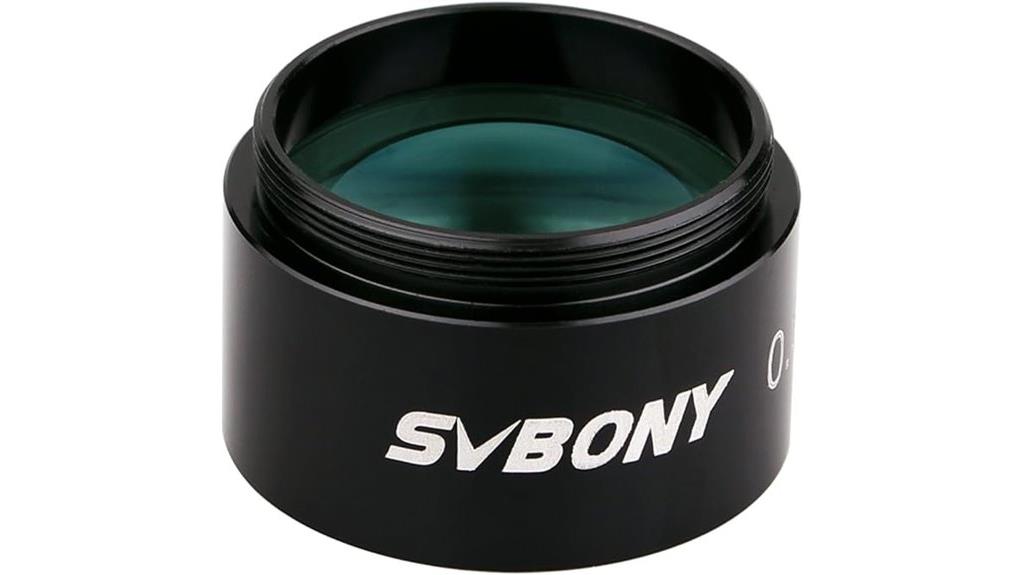
If you’re looking to expand your astrophotography capabilities with a versatile and easy-to-use accessory, the SVBONY 0.5X Focal Reducer is a great choice. It halves your telescope’s focal length, giving you a wider field of view for both observing and imaging. Compatible with 1.25-inch eyepieces, it’s straightforward to attach and use. Fully multi-coated surfaces boost contrast and clarity, while its durable metal construction ensures stability during your sessions. Whether for visual observation or CCD imaging, this focal reducer enhances your setup’s performance, making it a reliable, cost-effective tool for capturing stunning celestial images.
Best For: amateur astronomers and astrophotographers seeking an easy-to-use accessory to expand their observational and imaging capabilities with wider fields of view.
Pros:
- Halves the telescope’s focal length, providing a broader field of view for both observation and imaging.
- Fully multi-coated surfaces enhance contrast and image clarity.
- Durable metal construction ensures stability and reliable performance during sessions.
Cons:
- Slight reduction in image brightness due to focal reduction.
- Compatible only with 1.25-inch eyepieces, limiting use with larger or different sizes.
- May require additional adapters for some telescope models or accessories.
SVBONY 0.5X Telescope Focal Reducer for Eyepieces
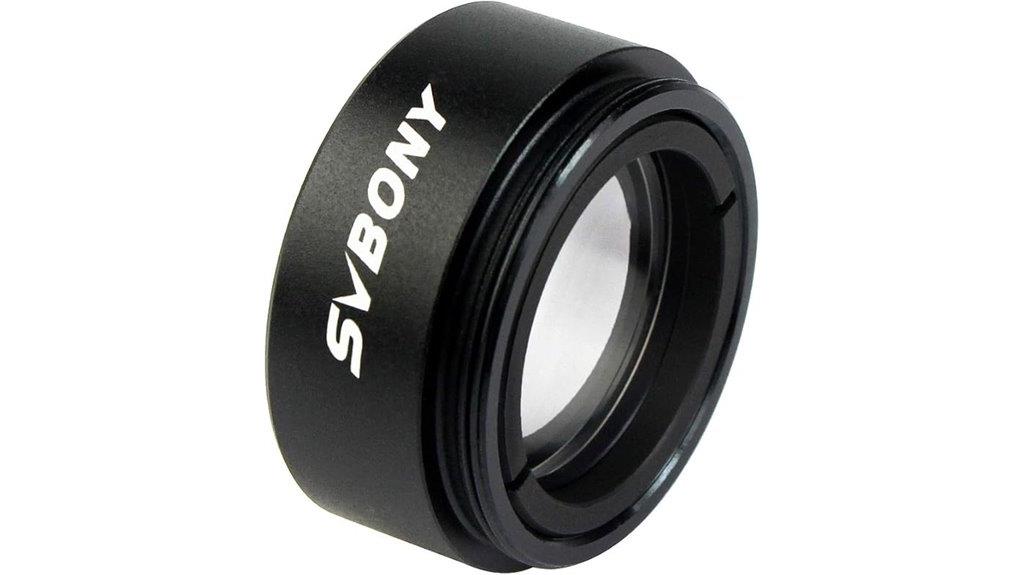
The SVBONY 0.5X Telescope Focal Reducer is an excellent choice for astrophotographers seeking to widen their field of view and reduce exposure times, especially when working with standard 1.25-inch eyepieces. It reduces the telescope’s focal length by half, making it easier to capture large objects and quicken image acquisition. Constructed from durable metal with multi-coated optics, it offers solid build quality. However, some users report threading issues and chromatic aberration, particularly with fast scopes. Overall, it’s a cost-effective option for enhancing astrophotography, but keep in mind its limitations with certain telescopes and wide-angle eyepieces.
Best For: amateur astrophotographers and stargazing enthusiasts looking to expand their field of view and reduce exposure times with standard 1.25-inch eyepieces.
Pros:
- Effectively reduces focal length by half, broadening the field of view for large object imaging.
- Constructed from durable metal with multi-coated optics for reliable use.
- Affordable option with positive customer support and quick shipping.
Cons:
- Some users experience threading issues and difficulty attaching the reducer securely.
- May introduce chromatic aberration and optical distortions, especially with fast or wide-angle telescopes.
- Limited optical performance at this price point, not suitable for high-precision or wide-angle visual observations.
Celestron 93633-A SLR or DSLR T-Adapter (C5, 6, 8, 9.25, 11, 14), Black
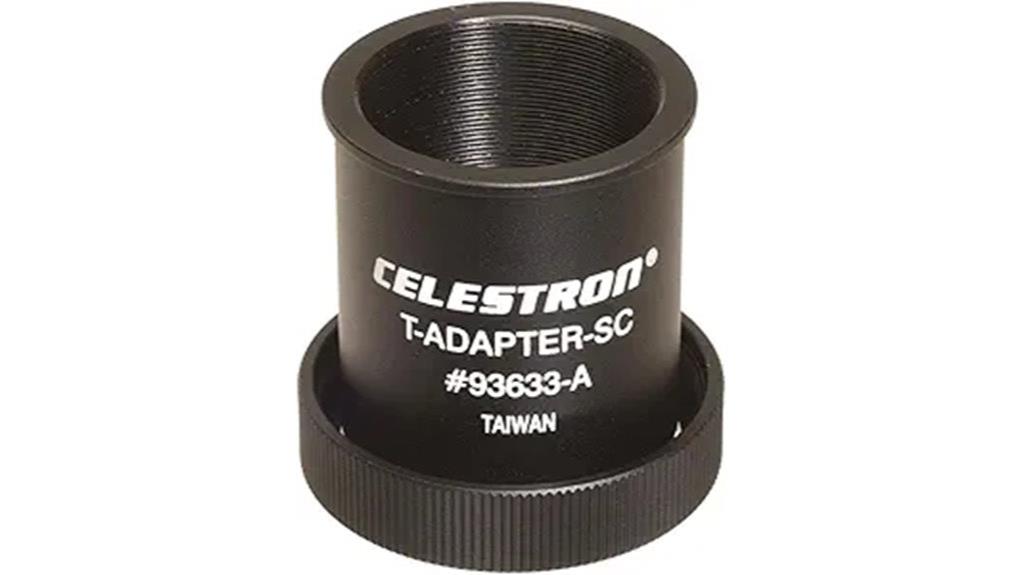
For astrophotographers using Celestron Schmidt-Cassegrain telescopes, the 93633-A SLR or DSLR T-Adapter offers a reliable way to attach cameras directly to their telescopes. Designed specifically for models 5, 6, 8, 9.25, 11, and 14, it enables prime focus astrophotography, delivering high-quality images. The adapter threads onto the rear of the telescope and works with camera T-Rings (sold separately), ensuring a secure fit. Its black finish adds a professional touch, while the precise threading guarantees a stable connection. Overall, this T-Adapter simplifies camera attachment, making it a valuable accessory for capturing detailed astrophotos.
Best For: amateur and professional astrophotographers using Celestron Schmidt-Cassegrain telescopes who want to attach their DSLR or SLR cameras for prime focus imaging.
Pros:
- Facilitates high-quality astrophotography by enabling direct camera attachment at prime focus
- Compatible with multiple Celestron Schmidt-Cassegrain telescope models (5, 6, 8, 9.25, 11, 14)
- Secure, precise threading ensures a stable connection between telescope and camera
Cons:
- Requires separate purchase of camera T-Rings for compatibility
- Installation may be challenging for beginners unfamiliar with telescope accessories
- Limited to Celestron Schmidt-Cassegrain telescopes; not compatible with other telescope types
Alstar 0.5X Reducer for Photography and Observing

The Alstar 0.5X Reducer is an excellent choice for astrophotographers and astronomers seeking to expand their view without sacrificing image quality. It effectively halves your telescope’s focal length, making it ideal for wide-field deep-sky imaging and observing. With a focal length of around 85 mm and a 22.5 mm aperture, it ensures bright, clear images through compatible 1.25-inch eyepieces and camera adapters. Its compact, black anodized aluminum housing is durable and lightweight. You can stack it with other accessories for further reduction. Overall, it’s a versatile tool to enhance your astrophotography setup, especially for longer focal ratio telescopes.
Best For: astrophotographers and astronomers using longer focal ratio telescopes seeking wider fields and lower magnification for deep-sky imaging and observing.
Pros:
- Halves the telescope’s focal length for wider views and shorter exposure times
- Compatible with standard 1.25-inch eyepieces and camera adapters for versatile use
- Compact, lightweight, and durable with black anodized aluminum housing
Cons:
- Limited to use with telescopes and accessories that have compatible 1.25-inch threads
- Customer rating indicates some users may experience variability in image quality or fit
- Additional spacers are required for further focal reduction, which may involve extra cost and setup complexity
Celestron Telescope Accessory Bundle (f/6.3 Reducer & T-Ring)
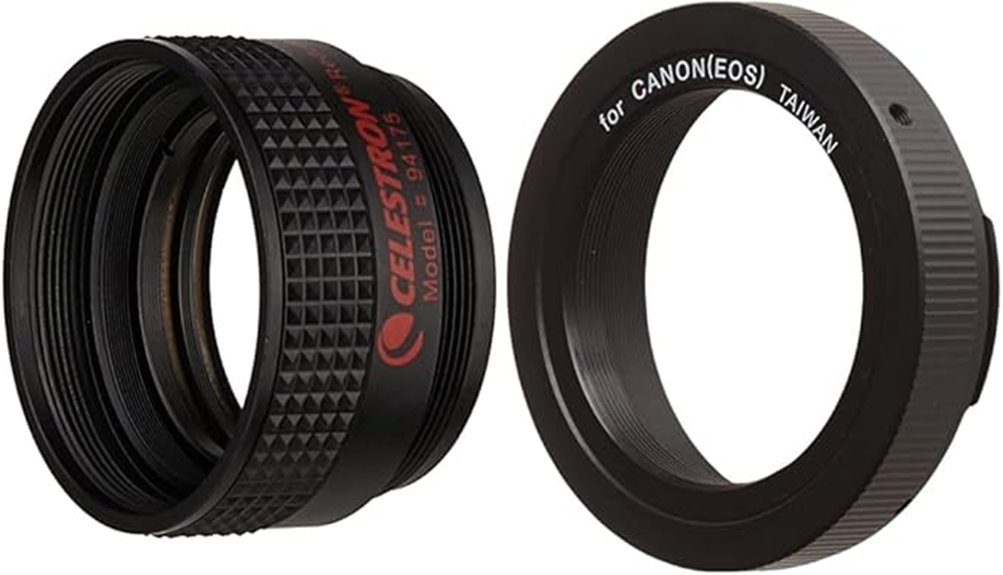
If you’re looking to boost your astrophotography capabilities with a versatile and reliable accessory, the Celestron Telescope Accessory Bundle (f/6.3 Reducer & T-Ring) is an excellent choice. It combines a focal reducer and field corrector compatible with several Celestron Schmidt-Cassegrain models, reducing exposure times and expanding your field of view. The bundle also includes a T-Ring for Canon EOS cameras, making it easy to attach your DSLR for prime focus imaging. Designed for visual and photographic use, this setup improves image quality, broadens your astrophotography options, and is built with quality craftsmanship for consistent performance.
Best For: amateur astronomers and astrophotographers seeking to enhance their imaging capabilities with versatile accessories compatible with Celestron Schmidt-Cassegrain telescopes.
Pros:
- Reduces exposure time by a factor of 3, improving imaging efficiency
- Compatible with multiple Celestron Schmidt-Cassegrain models, offering versatility
- Includes a T-Ring for easy attachment of Canon EOS DSLR cameras, facilitating prime focus photography
Cons:
- Not compatible with Celestron EdgeHD systems, limiting its use for certain models
- Requires proper attachment and compatible adapters for optimal performance
- Does not include additional accessories like Tele-Extenders or specialized adapters for other camera brands
GSO 0.5X Focal Reducer, 2 (50.8mm) Diameter, Made in Taiwan
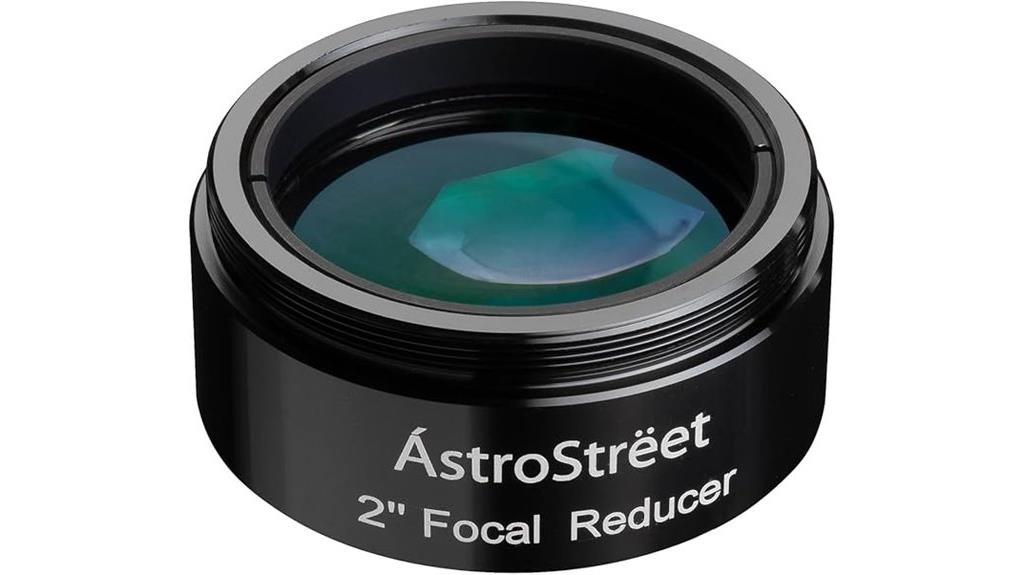
The GSO 0.5X Focal Reducer stands out as an excellent choice for astrophotographers seeking to widen their field of view while maintaining high optical quality. Made in Taiwan by a reputable OEM manufacturer, it features a CNC-machined aluminum body and Hooley multi-coated lenses that reduce reflections and boost image clarity. With a 2-inch diameter, it effectively reduces focal length by half, making it ideal for capturing expansive sky scenes. Weighing about 2.5 ounces, it’s lightweight and easy to attach. This focal reducer offers reliable performance, solid craftsmanship, and sharp, high-contrast images—perfect for elevating your astrophotography experience.
Best For: astrophotographers and telescope enthusiasts looking to expand their field of view with high-quality optical performance.
Pros:
- High-quality CNC-machined aluminum construction offers durability and a premium appearance
- Fully multi-coated Hooley lenses enhance image clarity and reduce reflections
- Lightweight design (about 2.5 ounces) makes it easy to handle and attach
Cons:
- Only reduces focal length by 0.5x, limiting versatility for other optical adjustments
- Designed specifically for 2-inch telescope accessories, limiting compatibility with smaller setups
- May require additional adapters for certain telescope models or camera types
Factors to Consider When Choosing a Celestron Focal Reducer
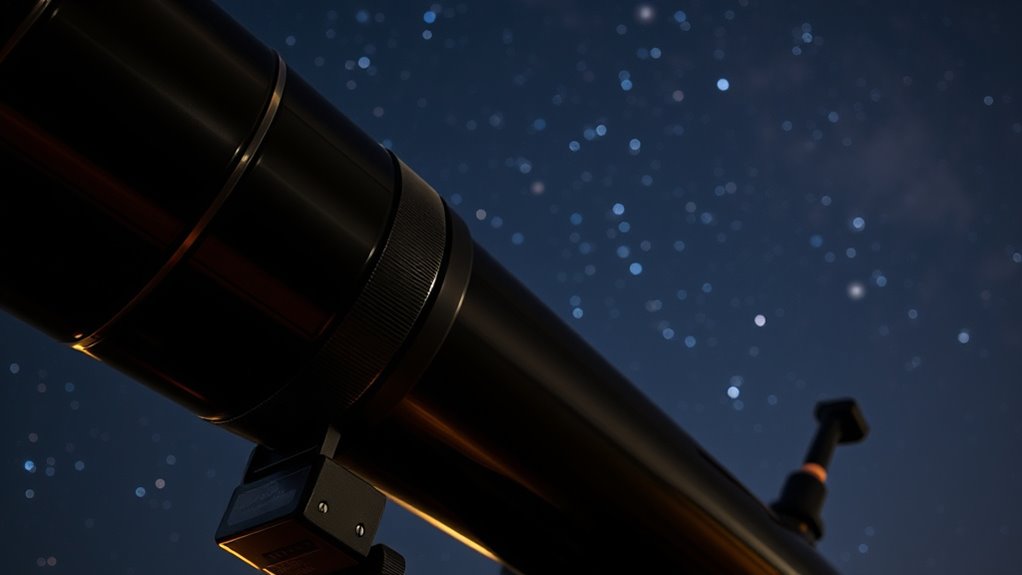
When choosing a Celestron focal reducer, I consider compatibility with my telescope to guarantee a perfect fit. I also look at the focal reduction ratio and optical quality to get the best image enhancement, along with build durability for long-term use. Finally, I check how easy it is to attach and handle, so my setup remains straightforward and reliable.
Compatibility With Telescopes
Choosing the right Celestron focal reducer depends heavily on guaranteeing compatibility with your specific telescope model. First, verify that the reducer is designed for your telescope type, such as Schmidt-Cassegrain or EdgeHD, to ensure proper fit and function. Check the thread type and size to match your telescope’s rear port, typically SCT threads or standard fittings. It’s also essential to confirm that the reducer maintains the correct back focus distance specified for your telescope, as this impacts image quality. Additionally, consider whether the reducer’s optical design suits your telescope’s aperture and focal length to avoid issues like vignetting or aberrations. Ultimately, verify it’s compatible with your existing accessories or camera systems to streamline your astrophotography setup.
Focal Reduction Ratio
Understanding the focal reduction ratio is essential because it directly influences how your telescope captures and displays images. It determines how much the focal length is decreased, usually expressed as a percentage or factor like 0.7x or 37%. A lower ratio, such as 0.5x, markedly reduces focal length, resulting in a wider field of view and faster imaging. Common ratios like 0.7x, 0.63x, and 0.5x offer different balances between field expansion and image scale. The ratio also affects the telescope’s effective focal ratio, turning a long f/10 system into something faster like f/6.3 or f/5. Choosing the right ratio depends on your goals—whether you prioritize wider sky coverage or higher magnification.
Optical Quality Standards
Optical quality standards play a vital role in selecting the right Celestron focal reducer, as they directly impact image sharpness, contrast, and overall performance. I pay close attention to the level of multi-coating on lens surfaces, since fully multi-coated optics boost light transmission and reduce reflections, resulting in clearer images. The number of lens elements and their design—whether 4- or 5-element systems—also matters, as they help correct aberrations and sharpen details. Premium materials like Lanthanum glass and advanced coatings further minimize chromatic aberration, enhancing clarity. Additionally, manufacturers’ commitment to precision manufacturing, including CNC machining and rigorous optical testing, guarantees consistent performance and reliable results. These standards are essential to achieving peak astrophotography quality with your focal reducer.
Build Durability
When selecting a Celestron focal reducer, build durability is a crucial factor that guarantees it can withstand the rigors of regular use and harsh conditions. I look for models with CNC-machined aluminum housings because they resist corrosion and impacts, ensuring longevity. Fully multi-coated lenses made from high-quality optical glass not only improve image quality but also protect against scratches and environmental damage. Rubber or shock-absorbing housings help absorb vibrations and shocks, extending the accessory’s lifespan. Precise threading and secure attachment points are essential to prevent accidental detachment or cross-threading during use, maintaining structural integrity. Additionally, features like dust caps and protective cases shield the optics from dust, moisture, and physical damage, ensuring the focal reducer remains reliable over time.
Ease of Attachment
Choosing a Celestron focal reducer that attaches easily to your telescope is essential for a smooth observing or imaging experience. I look for reducers with compatible threading or attachment mechanisms that match my telescope’s rear port or visual back, ensuring a secure fit. It’s important that the reducer includes all necessary adapters or can be threaded onto existing equipment without extra tools, saving time and effort. I also verify that the attachment points are stable to prevent slipping or misalignment during use. A design that allows for smooth installation and removal without risking damage to optical components makes setup hassle-free. Additionally, dust caps and protective features are a plus, as they help keep everything clean and safe during handling or when switching setups.
Field of View Gain
A focal reducer’s ability to expand your telescope’s field of view can substantially enhance your astrophotography and visual observation experiences. By effectively decreasing the focal length, it allows you to capture larger sections of the sky in a single shot. Typically, a 0.7x focal reducer increases the field of view by about 43%, making it easier to photograph extended objects like nebulae and star clusters without mosaics or multiple images. This broader view not only saves time but also improves your ability to frame and include more celestial details in one exposure. However, keep in mind that some optical distortions might occur at the edges, so choosing a high-quality reducer is essential to maximize field gain while maintaining image quality.
Price and Value
Evaluating the price and value of Celestron focal reducers helps guarantee you get the best performance for your investment. Comparing different models’ prices helps identify the best bang for your buck while ensuring quality. Higher-priced options often feature advanced multi-coated optics and rugged construction, which can justify the cost through better image clarity and durability. Budget-friendly focal reducers might deliver basic optical performance but could lack coatings or sturdy build quality, impacting long-term value. It’s also smart to contemplate included accessories like dust caps, adapters, or cases, as these add to overall worth. Don’t forget to check warranty and support — extended coverage can make pricier models more worthwhile by offering peace of mind and reliable service down the line.
Frequently Asked Questions
How Does a Focal Reducer Affect Image Brightness and Contrast?
A focal reducer increases image brightness and contrast by reducing the telescope’s focal length, which allows more light to reach the camera sensor. This results in brighter images with better detail, especially in low-light conditions. I’ve found that it also improves contrast by minimizing optical aberrations, making it easier to capture sharper, clearer astrophotos. Overall, it’s a valuable tool for enhancing both brightness and contrast in your astrophotography.
Can Focal Reducers Be Used With All Types of Telescopes?
Think of focal reducers as universal keys that can fit many telescopes, but not all. I’ve found that they work best with Schmidt-Cassegrain or Maksutov designs, enhancing wide-field views. However, some refractors or specialized scopes may not be compatible without adapters or specific models. So, I always double-check my telescope’s specs before trying to attach a focal reducer to guarantee a snug fit.
What Is the Optimal Focal Length Reduction for Astrophotography?
The ideal focal length reduction for astrophotography is typically around 0.63x to 0.5x, which balances wider fields of view with sharp image quality. I find that a 0.63x reducer works well for capturing large nebulae and star clusters, while a 0.5x offers even broader views but can introduce some vignetting. Adjust based on your target and camera setup for the best results.
Are There Compatibility Issues Between Focal Reducers and Camera Sensors?
Did you know that about 30% of astrophotographers report compatibility issues with focal reducers and camera sensors? I’ve found that choosing the right reducer is essential, as some may cause vignetting or image distortion on certain sensors. I always double-check the specifications and compatibility charts before purchasing. For instance, some Celestron reducers work perfectly with APS-C sensors, but full-frame sensors often need different adapters or reducers.
How Do I Maintain Focus Accuracy When Using a Focal Reducer?
To keep focus accuracy when using a focal reducer, I always start with fine adjustments after attaching it. I use a high-quality focuser and take test shots, checking for sharpness and star diffraction. I also verify the reducer is snug but not overly tight, as slight movements can throw off focus. Regularly rechecking focus during sessions helps me maintain crisp images throughout my astrophotography.
Conclusion
If you’re serious about boosting your astrophotography, these Celestron focal reducers are game-changers. Did you know that using a reducer can increase your field of view by up to 43%, allowing you to capture more of the night sky? With options tailored for different needs and budgets, there’s never been a better time to upgrade your gear. Trust me, enhancing your telescope with one of these reducers will open up a whole new universe of astrophotography possibilities.
